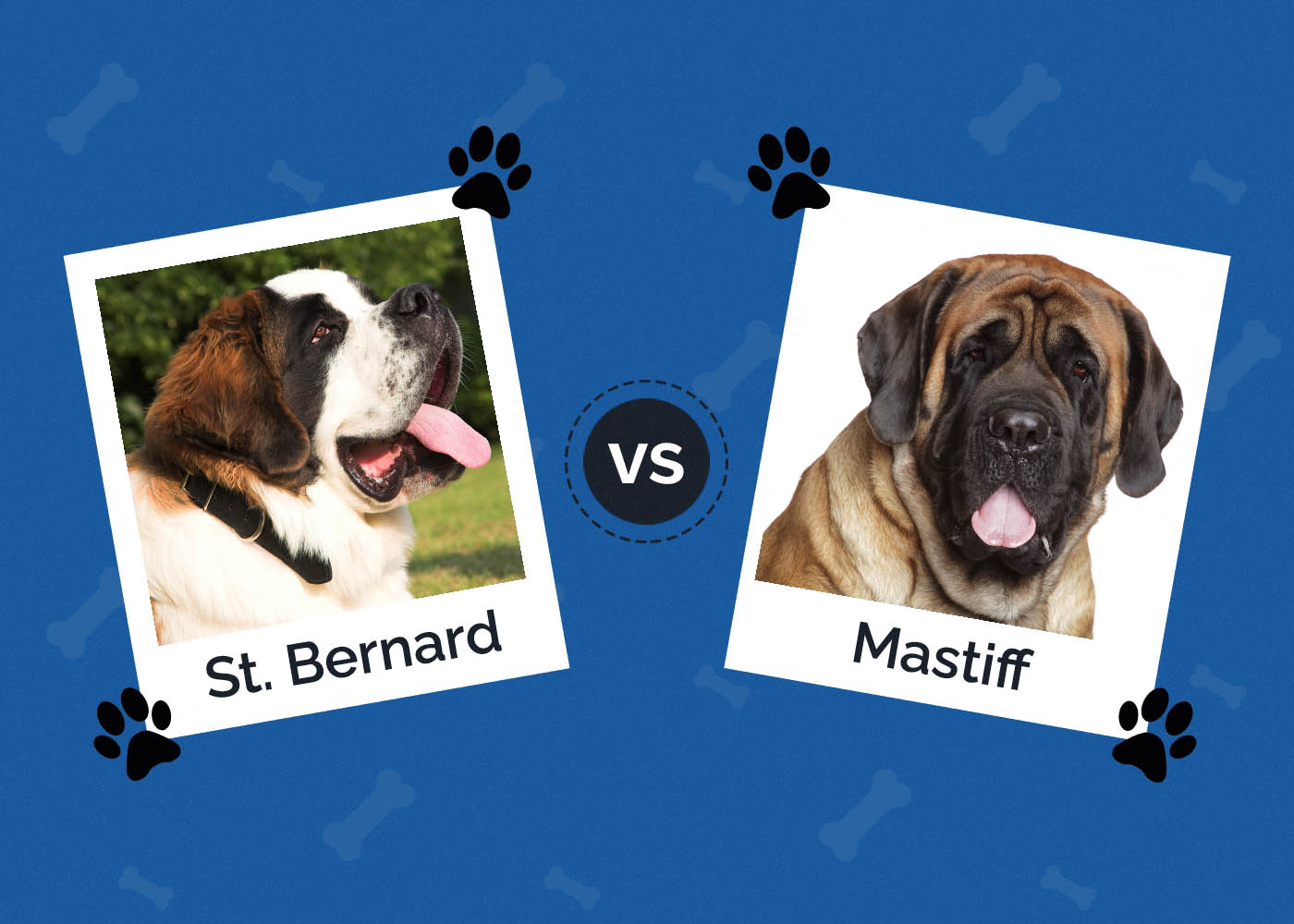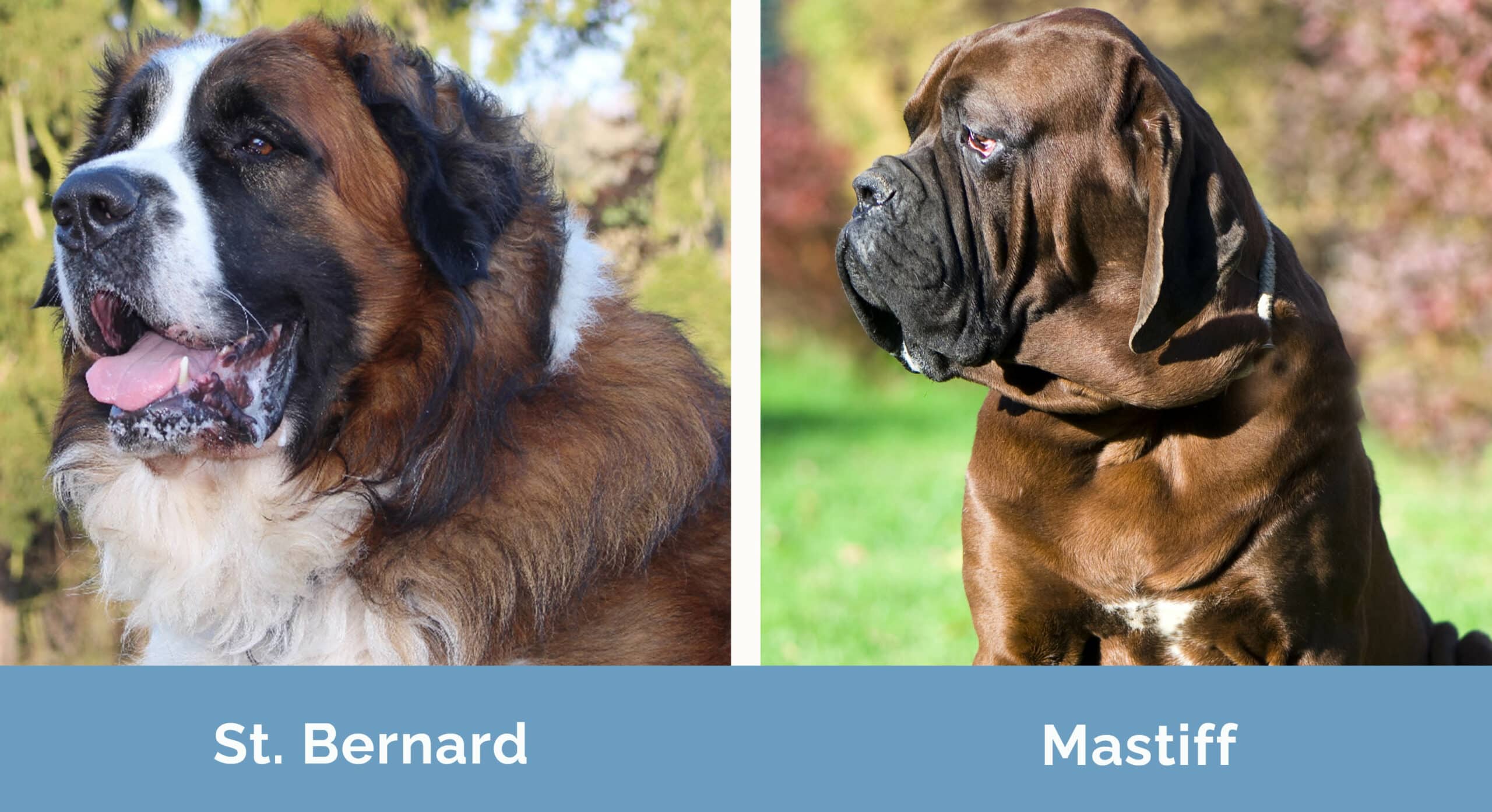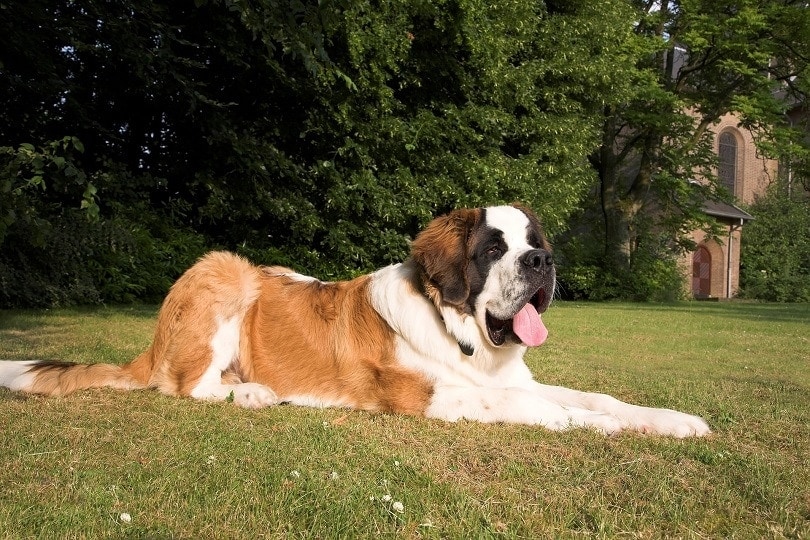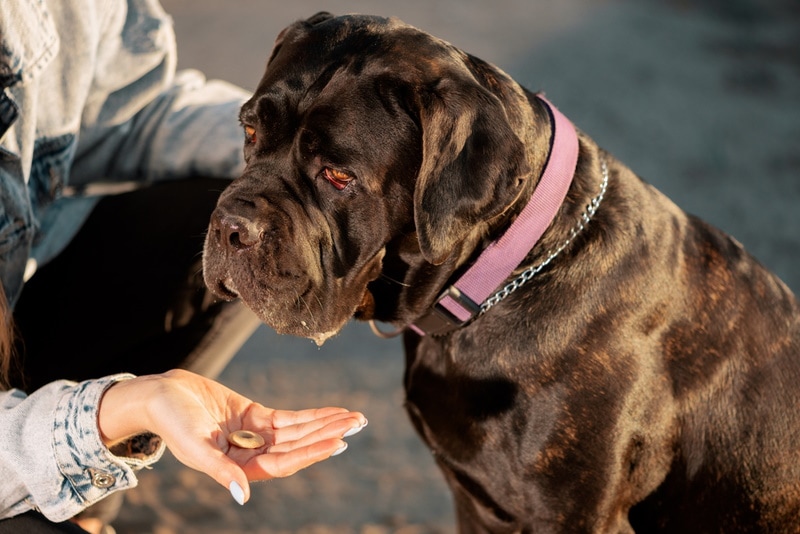St Bernard vs Mastiff: Key Differences (With Pictures)

Updated on

Click to Skip Ahead
The St Bernard is a well-recognized breed thanks to its famous role in the popular family film Beethoven. There is a lot you can learn from watching the movie, but owning one will be a unique experience. They have big hearts, are naturally gentle, and do well with kids. They are easily trained but can be a lot to handle, but once you get on top of it, you will have an incredible watchdog and companion.
The Mastiff has a well-known history as a protector, and nothing has changed today. They may seem intimidating, but they are lovable and loyal companions with the right owner. They are intelligent and confident but often show affection with their slobbery kisses.
If you are considering a St Bernard or Mastiff as your new family pet, they are both incredibly large breeds that will bring different needs, challenges, and skill sets to your life, but they make excellent pets.
Visual Differences

At a Glance
- Average height (adult): 26–30 inches
- Average weight (adult): 120–180 pounds
- Lifespan: 8–10 years
- Exercise: 1+ hours a day
- Grooming needs: Moderate
- Family-friendly: Yes, good with children
- Other pet-friendly: Yes
- Trainability: Smart, quick to learn, stubborn at times
- Average height (adult): 27–30 inches
- Average weight (adult): 120–230 pounds
- Lifespan: 6–10 years
- Exercise: 1+ hours a day
- Grooming needs: Easy
- Family-friendly: Yes
- Other pet-friendly: Often
- Trainability: Enjoy pleasing their owner, intelligent
St Bernard Overview

Temperament
St Bernards are known and loved for their large size and large hearts. Despite their giant-like appearance, they have a gentle demeanor. Like most dogs, they are playful and energetic as puppies, but as they get older, they become a lot calmer. St Bernards are kind and good-natured, and although they seem goofy, they are intelligent. They are also called “nanny dogs” as they are great with children and affectionate toward them and the whole family.
Health & Care
St Bernards are generally healthy and can live 6–12 years. However, like most breeds, St Bernard’s are predisposed to some medical issues such as:
Bloat and Gastric Dilatation-Volvulus (GDV): St Bernard’s have a deep chest and are prone to bloat. Bloat occurs when the stomach fills up with gas. Although bloat isn’t life-threatening, it can lead bloat can lead to GDV, which is life-threatening. GDV occurs when the bloated stomach twists and cuts off blood circulation to the stomach.
Hip Dysplasia: Hip dysplasia is a common orthopedic condition with large breed dogs. It occurs when the head of the thigh bone doesn’t fit flush into the hip joint, which causes it to rub and change structure over time. This results in inflammation and pain within the joint.
Osteosarcoma and Lymphoma: Osteosarcoma is a very aggressive bone cancer that develops quickly. Lymphoma starts in the lymph nodes and can spread to other organs.
Cervical Vertebral Instability (Wobbler Syndrome): Developmental abnormalities in the neck or spine cause a slow, progressive neurological disease known as Wobbler syndrome. This condition can cause pain, incoordination, and leg weakness, causing a dog to drag its feet.
Entropion: Entropion occurs when the eyelid rolls inward, causing the eyelashes to scratch the eye’s surface, which can be uncomfortable and painful and lead to corneal ulcers.
Nutrition

St Bernard’s should be fed a high-quality, well-balanced diet. It is recommended to feed them 90% dry and wet food, and you can feed treats to make up the other 10%. The packaging of your dog’s food should provide feeding guidelines, but your vet can also determine the proper portion sizes based on body size, age, and weight. It is also essential to prevent obesity, especially in a large breed like the St Bernard. The extra weight will put pressure on their joints, leading to arthritis and other joint and bone issues.
Training and Exercise
Surprisingly, St. Bernards only need a moderate amount of exercise. They will benefit from and be happy with at least one long walk or 30 minutes of play with their owner. With that said, St Bernard’s is prone to heat exhaustion, so you should avoid exercising and playing in the heat of the day and ensure plenty of water and shade is always available.
Like all dogs, training and socialization are crucial from an early age. St Bernards are eager-to-please, intelligent, fast learners, which makes it relatively easy to train them. However, their powerful size can make them difficult to handle.
Puppy training and socialization classes are helpful and recommended for this breed. Obedience classes are also recommended to train your St Bernard to obey commands. Obeying these commands will keep them from jumping up on people and being too excited around children, which is important when owning a large breed dog.
Special training will be required if you want to adopt a St Bernard for search and rescue purposes.
Grooming
St Bernards can have long-haired or short-haired coats, both of which require brushing once or twice a week. They shed twice a year and require extra grooming during that time. An occasional bath will help keep their coat and skin clean, and they will also require daily teeth brushing and frequent nail clipping.
St Bernards are also prone to tear staining, but you can use a warm cloth to wipe their eyes. Their love for water paired with large ear canals also makes them prone to ear infections, so they will need their ears cleaned every 2–3 weeks and after swimming or bathing.

Suitable for:
St Bernards are suitable for any family, especially those with children. They are affectionate and protective, which makes them excellent family pets. They require a family that is available to give them time and attention, as they love being around their family members.
They also enjoy camping and hiking trips, which makes them an ideal companion for an adventurous family. A St Bernard is not suited to a family or owner who is away most of the day as they can develop separation anxiety and become destructive.
They will need lots of space to move and run around, even though they are happy to be indoors, and it’s important not to underestimate their size and strength when playing and training. They will be happy in a large yard, but if you are an avid gardener who is protective over your beds, a St Bernard may not be your ideal companion since they love to dig.
- Affectionate
- Intelligent
- Loyal
- Protective
- Great with kids
- Calm and gentle
- Moderate exercise and grooming needs
- Likes to dig
- Can’t be left alone for long periods
- May be hard to handle when training
Mastiff Overview

Temperament
The history of the Mastiff as a guardian continues today as these intimidating and loyal canines remain watchful and protective over their family. They are also patient, lovable, and loyal, which makes them excellent companions. They are surprisingly calm and good-natured. Because of their natural suspicion of strangers, early socialization and training are essential.
Health & Care
Most breeds, like the Mastiff, have shorter lifespans than smaller breeds, but despite a lifespan of 6–10 years, Mastiffs are generally healthy dogs. Like St Bernard, they are also predisposed to health issues such GDV, hip dysplasia, entropion, osteosarcoma, and lymphoma, along with other potential health issues such as:
Progressive Retinal Atrophy (PRA): PRA is a genetic disorder that causes a dog to lose its eyesight within 1–2 years.
Degenerative Myelopathy (DM): DM is the gradual loss of the myelin and axons that comprise the spinal cord’s nerve conduction system. A dog will experience weakness, an unnatural walk, and ultimately paralysis of the hind limbs as the condition worsens. Usually, a dog cannot walk on their rear limbs approximately a year after the initial signs are noticed.
Nutrition

Like all dogs, a Mastiff will need a high-quality, well-balanced diet. However, choosing the best diet will come down to your dog’s needs, which you can discuss with your veterinarian. Mastiffs will generally thrive on brands approved by the Association of American Feed Control Officials (AAFCO) and specifically formulated for large breeds. They will need large-breed puppy food for up to 14–18 months when they can gradually switch to an adult formula. Like the St Bernard, a Mastiff may benefit from a joint supplement, depending on the vet’s recommendation.
Training and Exercise
Mastiffs are not very active, but they will require at least an hour of exercise each day. They enjoy interactive play with their owners and long walks. Mastiffs are an intelligent breed and can be trained easily. Proper training and socialization should occur at a young age for one to grow into a well-rounded dog.
Early socialization and training are vital with Mastiffs because these naturally born guard dogs are wary of strangers. Mastiffs also excel at nose sniffing and trick training, but agility is their strong point in competitive sports.
Grooming
Mastiffs don’t require much grooming. Their coat is short and dense, and they are moderate groomers. Their grooming routine will consist of weekly brushing and occasional bathing, daily teeth brushing, frequent nail trimmings, and ear cleaning. Mastiff pet parents need to be sure that their facial folds are kept clean since they are excessive droolers. Their faces need to be wiped daily to prevent dermatitis or infections.

Suitable for:
A Mastiff is well suited to a family that is looking for a loyal guard dog, as well as a loving companion. Mastiffs will be great for most families with the time and energy to train them. However, families with small children need to consider that although they’re great with kids and will be excellent protectors, the size and strength of the dog put toddlers at risk of injuries.
This is true for elderly owners as well. Mastiffs will need a lot of space to run around and stretch out, so they are more suited for large homes than apartments. They will also need a family where someone can be with them as they may develop separation anxiety if left alone for long periods.
- Excellent guard dogs
- Loyal
- Protective
- Lovable
- They are excessive droolers
- Not ideal for a jogging companion
- May be too big for children
Which Breed Is Right for You?
The St. Bernard and Mastiff will make excellent companions and guard dogs. Choosing which breed is right for you will be determined by minor differences, and the overall decision may be based on appearance. They are both loyal, affectionate, and loving and will be suited to families with kids. However, their size may be a hazard for tiny tots who may be unintentionally hurt or knocked over. Owning a large breed like these two will require early training and socialization, a large space, and a family who can be at home with them. If you love spending time in your garden, a Mastiff is a safer choice since St Bernards tend to dig.
However, if you are intolerant of heavy drooling, you may lean more toward a St Bernard. St. Bernards are also better for families that enjoy hiking and camping. Whichever breed you choose, you will surely have many years of loyalty, unconditional love, and companionship.
See also:
Featured Image Credit: (L) Jumpstory | (R) Jagodka, Shutterstock












